Frequently, my (Gene) customers ask me: “What are your main objectives, as an organizational and agile coach? What are you planning to accomplish, while engaging with us?“.
Before I answer this question, I want to make a very important statement: it is critical that a client understands that this question has much more value when asked at earlier stages of client-coach engagements. Delayed discussions of this important topic, may lead to misunderstanding and setting false expectations by both parties.
Typically, such conversation should happen around time, or right after, a coach performs an initial agile transformation readiness assessment of a client, analyzing its organization as a whole: structure, dynamics, culture. If the topic of objectives is discussed timely, it will ensure that both parties can monitor progress of coaching towards success, while applying necessary course correction and avoiding “internal contracts” at later stages.
And here comes the answer-view, that may sound bit of a cliche, yet is widely shared by many professional coaches:
“My main objectives as an organizational coach, are to make sure that your Organization, as a whole, achieves its own main objectives, defined its own system-optimizing goals. Of course, an organization can do so by leveraging my experience, guidance and various coaching/training techniques that I may offer, however, the found ways and solutions must belong to an organization, not to me. I am NOT here to seek glory for personal achievements or impress you with my individual performance. I am here to help you achieve your personal success and improve your own organizational performance by helping you seek your own ways. I am perfectly OK if you take a full credit for all of good work that we do together. My greatest achievement is your full satisfaction with your own improved performance. I will be happy to fully disengage (or reduce engagement intensity) when we both agree that your organization has achieved a desirable level of maturity and autonomy, and further reliance on my coaching is no longer necessary (or can be reduced). My ultimate objective is to coach myself out of the job“
To say it differently, personal objectives of a coach are to continuously reflect a client’s progress towards its own objectives, while providing guidance and course correction.
Based on years experience, below, I have summarized the list of Top-10 objectives (please note: my objectives) that can bring to synergy intentions of a dedicated agile coach with intentions of a client:
1 – Organizational “Laloux Color”: from Orange to Green

Here, the main and by far, the most overarching objective in agile transformations, is to move an organization away from “Orange” to “Green” level of consciousness, with the latter being an optimal place to be in, for organizations seeking adoption of Agile culture (as per Frederic Laloux’s “Reinventing organizations“).
The main characteristics of Orange organization are pretense of clearly defined goals to beat competition (sometimes both, internal and external) and to achieve profit and growth. Here, innovation is the key for staying ahead, and management is performed by meeting objectives, with managers “commanding and controlling its employees on “what“, while giving liberty on deciding “how” to workers. Leadership style in Orange predominantly goal- and task-oriented. The most common examples of Orange organizations are multinational, enterprise-size companies and charter schools. Metaphorically speaking, an Orange organization is “the machine”.
The main characteristics of Green organization are focus on improving organizational culture by empowering employees and helping them develop high intrinsic motivation. Leadership style in Green organizations is predominantly consensus & service-oriented and participative. The most common examples of Green organizations are the ones that are culture-driven (as opposed to conventional organizational structure-driven): Southwest Airlines; Ben&Jerry‘s. The hallmarks of Green organizations are empowerment of employees, values-driven culture and “employees as stakeholders” philosophy. Metaphorically speaking, Green organization is “the family“.
Many organizations that primarily reside in orange space, have localized pockets (“islands of happiness“) that ascend to green and either remain there or descend back to orange, situation-ally. The opposite is true too: organizations that reside predominantly in green space may, in part or in full, descend back into orange, under certain conditions.
Please, refer to Frederic Laloux’s book “Reinventing organizations“, his presentation on the same topic, a series of videos (Insights for the Journey), or to Peter Green’s video animation “Lean and Agile Adoption with the Laloux Culture Model” to further understand organizational levels of consciousness as well as learn about the levels that are below Orange or above Green.
2 – Organizational Tribal Stage: from Stage 3 to Stage 4

Here, the shared objective of an organization and its coach is to help employees gradually advance, metaphorically speaking, from Tribal Stage 3 to Tribal Stage 4 of mindset maturity (based on
Tribal Leadership: Leveraging Natural Groups to Build a Thriving Organization by Dave Logan, John King and Halee Fischer-Wright)
, where:
Tribal Stage 3 – is being characterized by employees operating in clusters and attempting to outperform each other and beat each other to get a bigger reward. At this stage, everyone is striving for dominance; individuals express behaviors of “lone warriors” with organizational culture reminding “wild, wild west.”
Metaphorically speaking, individuals at this stage of mindset maturity express “I am great” (in background “you are not“).
and
Tribal Stage 4 – is being characterized by employees forming structures called triads (building values-based relationships between one another). At this stage, individuals, express tribal pride, mutual support, collective thinking, team work and shared ownership.
Metaphorically speaking, individuals at this stage of mindset maturity express “We are great” (in background “they are not”).
In order to adopt agile culture, individuals’ mindsets must evolve to Tribal State 4. One significant factor that makes this evolution more natural is providing proper motivation by organizational leadership. Please refer to the diagram that illustrates relationship between Evolution of Human Operating System (Motivation 3.0) to Evolution of Tribal System
3 – Organizational Structure: from Silos to Transparency
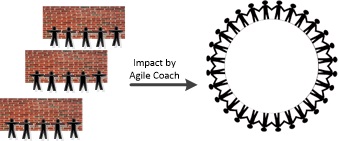
Here, the main objective of a coach is to help senior management bring down walls that separate different parts of the same organization, in order to increase transparency and improve communication.
Organizational silos are a problem that is not specific to technology departments only. Lack of transparency, poor communication, distortion of information as it flows through multiple organizational layers – is what describes many organizational departments, especially of large companies.
Despite a common but inaccurate belief that improving of agility is a sole responsibility of technology departments, a coach should work through multiple organizational segments (horizontally as well as vertically), trying to ensure people move away from negotiating contracts, towards collaboration and searching for workable solutions.
In this effort, to a large extent, a coach will rely on forming partnerships with organizational leaders that represent different organizational structures, not just technology. Frequently, such leaders happen to be officially designated strategic partners of CTO or CIO but their “partnership” does not go any further than an organizational chart. In cases like these, a coach’s goal is to help organizational leaders’ relationships evolve from being just “names on paper, connected by dotted lines” bound by political agenda, to politics-free and mutually supportive honest partnerships.
In many cases, this effort may require organizational re-design that includes the challenging existing hierarchies, tearing conventional reporting lines, blowing up “power houses” and bringing under the same roof individuals from previously separated organizational silos: organizations now become optimized not for functional control and pyramidal structures but for effective teaming, collaboration and stream-lined delivery.
Please, refer to DevOps Culture by Martin Fowler for more information on how removing organizational silos can improve organizational efficiency.
4 – Leadership: from Command & Control to Enable-ment
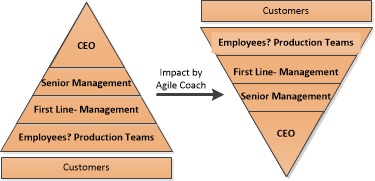
Here, the main objective of a coach is to help senior management promote culture of Servant Leadership, in pace of Command & Control.
This may require de-centralization of power and empowerment of lower layers of organizational pyramid. (Historically, archaic Tylorian organizational design was based on the opposite concept: separating work planners from work executioners.)
In order to develop agile culture, senior management needs to provide enough autonomy and sovereignty to organizational layers, that get work done.
However, “giving power back to people” does not have to mean a complete loss of control by senior leadership and anarchy: strategic, long-term decisions will still require involvement of individuals with deep systemic knowledge, authority and power. Senior leadership will still be deeply involved and held accountable for removing organizational impediments that retard progress at lower organizational layers. Senior leaders start acting more like servants and less like commanders, especially, for making tactical decisions at “trench” level.
Shifting an organization from Command & Control mindset to Servant Leadership mindset and delegating power to lower organizations layers may also call for an organizational flattening/de-scaling (please, also refer to Agility@Scale section). With certain mid-level management layers being reduced, it is not uncommon to encounter high level of resistance and attempts to sabotage agile transformation efforts (for reference, see Larman’s Laws of Organizational Behavior). This is probably one of the biggest challenges that an agile coach may face, while working with senior leadership on implications of adoption of Servant Leadership management style: how to improve organizational structure, without taking away job security from qualified individuals on one hand, but minimizing unnecessary or redundant roles on the other hand.
5 – Optimization: from Local Focus to Global/System Focus
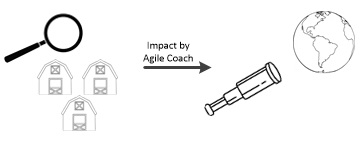
In System Thinking chapter of Large Scale Scrum, Local Optimization paradox is described very well by C. Larman and B. Vodde: “Everyone is doing their best yet overall systems throughput is degrading. How can that be?” This is the paradox of local optimization —when a person or departmental decision maker optimizes for the local view or self-interest. The party making the decision frequently believes they are making the best decision , but because ‘best’ is a local optimization, in fact it sub-optimizes overall system throughput…<to read more>”.
In real life, a good example of local optimization could be a department of business analysts successfully producing business specs, “as per end customers’ requests”, ahead of schedule, thoroughly documenting business requirements and “shelving” them for later consumption by technology department. Without looking at this situation systemically, it may appear that BA department works very effectively, since its throughput is high and deadlines are well met: from a local perspective, requirements gather process is optimized.
Meanwhile, technology department might still be struggling with delivering as per “previous set of specs”, fulfilling multiple change requests and fixing non-functional bugs that are the result of misinterpreting a prior batch of requirements. Technology is far behind schedule. Technology has also fallen behind in reviewing a “shipment” of new specs that just came from the department of successful BAs.
And of course, all of this is being thoroughly tracked with detailed project plans and Gantt charts, produced by PMO department: as per their RAG reporting to senior management, one department is locally successful, another department is locally in trouble. But what is not being communicated clearly is that due to inefficient organizational design, the overall system is undoubtedly failing, and the only way to see this clearly is by refocusing on global/system situation.
Here, the objective of agile coach is to work closely with senior management, to make sure it sees a bigger picture and perceives an organization as living organism or a large evolving Ecosystem, not as a collection of thin, independent and autonomous functional layers.
6 – Teaming: from Component Teams to Feature Teams
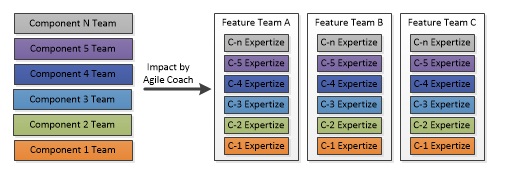
Here, the objective of a coach is to work with organizational leadership to restructure Technology departments away from Component-centric teams, towards Feature-centric teams.
The main characteristic of Component Team is high concentration of expertise in a specific product component (e.g. UI/UX, business logic, database), with very little or no expertise in other product components. Therefore, a component team can work only on “one flavor” of tasks and its deliverable rarely presents a complete and clear business value to customers. As a result of this situation, component teams ‘locally optimize’ (see Local vs. Global optimization section) themselves to stay busy and work on component-specific items that have much lower business priority.
Metaphorically speaking, a component team is able “bake only one layer of a tiramisu layered cake” – not something that a customer is likely to buy.
The main characteristic of Feature Team is presence of all types of component knowledge within the same, relatively small group of people (usually, cross-functional). A feature team can work autonomously and independently on one stand-alone product or on a single product area of larger product. A feature team, can optimize its work efforts around highest priority items (from business perspective), regardless of component specificity. This makes feature teams much more productive ‘delivery units’ than component teams. Metaphorically speaking, a feature team is able to “bake all layers of a layered cake” – something that a customer would be much more likely to buy.
Presence of feature teams makes agile product development possible; componetized team structure – much less likely: organizational silos (see Silos vs. Transparency section), hand-overs and ‘internal contracts’ significantly increase Cycle Time and decrease overall Throughput of delivery by component teams.
While component knowledge gets scattered across multiple feature teams, historical knowledge and core expertise can be still preserved and continuity ensured. How? In large scale product development (e.g. LeSS), for example, Component Communities of Practice (CoPs), is an effective way to ensure continuity of learning and richness of knowledge of any given component, throughout time.
Please, refer to Feature Team Primer and choosing between Feature Teams and Component Teams for further understanding of forming Feature Teams for agile product development.
7 – Workforce: from single-specialists to T-shaped workers
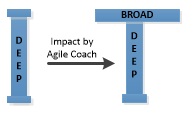
Here, the objective is to harvest T-shaped/cross-functional experts that can wear multiple hats (e.g. developer, tester, architect), on demand. The letter “T” is used to describe expertise of such individuals, with vertical (trunk) line of the letter, representing depth of primary/core knowledge and horizontal line of the letter, representing breadth of secondary knowledge. In contrast, “I-shaped” individuals have only primary/core knowledge/skill set but no secondary knowledge/skill set.
Why is this so important? In order to build efficient, cross-functional feature teams that can operate independently and work through an entire stack of system components, while delivering a ship-able product to end-customers, they (teams) need to be staffed with cross-functional team members. This ensures a higher degree of “swarming” by team members (working together on same tasks), more effective queue (WIP) management and higher Throughput. (Note: Irregular workflow and weakened scrum dynamics are frequently caused by lack of cross-functional team members – something that a coach needs expose to senior management that is responsible for creation of team structure.)
It is worth noting that while deep primary knowledge is commonly seen among many technologists, broader (secondary) knowledge is possessed by not so many. An organization that seeks to grow its population of T-shaped workers can do so by either providing an effective internal training or by hiring individuals from outside, with required multiple skills. In either case, in order for this effort to succeed, an organization must identify a clear career path for individuals that are willing to expand their technical horizons and learn additional skills and new technologies. For example, in order to encourage/motivate a business analyst learn programming skills, she has to be assured that for this effort she will be recognized by her line management, in favor of her career growth. This, in turn, may require changing HR policies in areas, such as criteria for hiring or performance appraisals (another challenging topic that is discussed below) – something that is not within immediate sphere of influence by first-level (line) management.
To take this a bit further, lets bring up another effective way to grow cross-functional individuals internally: have them cross-pollinate each other with knowledge as well as learn from one another. This, in turn, heavily depends on having a very collaborative (Green, as described above) consciousness, accompanied by mutual support and trust among co-workers, with insignificant levels of internal competition.
8 – Measuring Performance: from Individual to Team-based
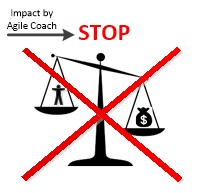
This has been one of the biggest and the most important topics for many organizational coaches. Here, the main objective of a coach is to make senior organisational leadership fully comprehend (as well as take responsibility for actions) a strong correlation between various elements of organizational an ecosystem that are typically viewed as independent. Individual performance measurement is one of very critical elements of an ecosystem and very often becomes its center-piece, as it defines behaviors of employees. Directly related to individual performance measurements, are promotions and performance-driven monetary rewards that define and get defined by employees’ goals, values and behaviors.
As early as at the middle of last century and with increased intensity in the last few decades, there have been volumes of research published and books written on the topics of performance appraisals, demoralizing effects of stack-ranking of employees, harm caused by rewards and subjective monetary incentives. It has been proven scientifically and sociologically, how these organizational practices damage employees’ morale and organizational cultures overall.
But the problem still exists! Primarily, it exists in Orange Organizations and there, it presents a serious impediment for adopting agile culture. For example, feature team work, collective ownership, joint delivery, mutual support of team mates, willingness to share knowledge with each other and many other “green behaviors” fall as victims to predominant “orange behaviors”, manifested by people with Tribal Stage 3 mindset: “I am the best”.
To stress again, from a practical perspective, a coach’s objective is not to completely change organizational values and norms during the course of a single coaching engagement (although great miracles are possible!). Instead, a coach should ensure that she educates an organizational leader(s) and makes them understand causes & effects in relationships between Orange Consciousness/Tribal Stage 3 and organizational potential to become more agile.
An extension to a coach’s objective should be also educating senior leadership on how to gradually move away from assessing individual performance, towards collective/team performance (moving towards Green Consciousness/Mindset Tribal Stage 4), and hopefully, over time, abolishing the concept of “performance measurement” completely, as it always leads to system gaming.
For additional resources (in abundance) please visit this page.
9 – Value Measurement: from “Check Marks” to ROWE
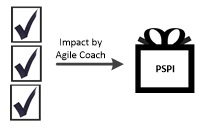
This topic is of particular significance for organizations, where a lot of emphasis is made on “check marks and score cards” used to measure accomplishments by individuals and teams. These are mainly large organizations, where production Cycle Time between initial idea and its practical implementation (from “concept and cash”) is long. In such organizations, true results (e.g. ROI, customer satisfaction) are possible to measure only when a product (or another tangible asset) actually comes to a market place. But since it does not happen frequently, organizations introduce interim measurements of value and success, mainly for reporting and book-keeping purposes.
Here are some examples of interim achievements that dont really prove that a deliverable carries any intrinsic business value, but rather represents a mechanism of “fake” value measurement: “how much time and effort has been put into producing a business requirements document?”, “how many people and how many total man-hours have been spent on producing a project plan?”, “are status meetings being held regularly and is everyone attending them?”. The main objective of an agile coach is to work with senior management and stakeholders to convince them into being less tolerant of approaches and techniques of subjective value measurement that rely on “imitation of value”, such as time spent. Instead, the goal should be to develop Results Only Working Environment (ROWE), where people are praised for producing tangible results, not based on time/efforts spent, but rather shippable deliverable that customers can put to use.
ROWE is one of the hallmarks of Daniel Pink’s Motivation 3.0 culture (also, a key to Stage 3 -> to -> Stage 4 transition), with individuals not being “extrinsically motivated” (a.k.a. manipulated) by various perks, rewards or other intensives.
10 – Agility @ Scale: from Complicating to De-Scaling
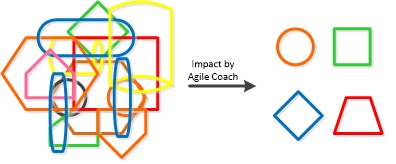
This situation is typically observed at large organizations, as they make attempts to scale agile across multiple organizational layers, departments or lines of business. It is not uncommon to see internal agile champions seeking scaling solutions that conveniently support existing organisational structures and require no or little organizational re-design. Frequently, complex agile frameworks are preferred because of their “unpack and install” capabilities. Such frameworks seamlessly fit over an existing organizational design and dont really challenge anyone’s status-quo, don’t call for dramatic changes and dont expose existing dysfunctions. They usually last until an organization catches on to the fact that nothing is changed and old dysfunctions prevail.
There is a mistaken belief by many large companies that in order to scale their agile practices they need a big solution. This is hardly true. In order to widen agile adoption and scale agile practices (e.g. scaling scrum), organizational de-scaling has to be done first.
A coach’s objective should be to work closely with senior leadership in helping them identify ways of re-structuring and descaling an existing organizational pyramid, by simplifying relationships, flattening organisational layers and increasing transparency.
Please, refer to this post to learn more about Agile Scaling via Organizational de-scaling.
Please, use the form below to submit your inquiry. If you are interested in training, coaching or consulting support, please provide, as much information as you can in the 'Message' field below:
